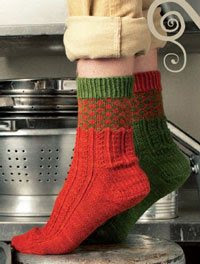Last week I published a post of selected bridal gown knitting patterns, and I've decided that post will be the first in a series on knitting patterns for weddings. I can't say how many posts there will be in this series, but I do have quite a few ideas in mind, so I'll just try to do one a week until I'm done. (You can see the other posts on knitting for weddings here.) This is the second post, and it features selected patterns for garters and hand-knitted bridal stockings. I'm trying to write this series of posts in such a way that they can also be of value to those who aren't planning a wedding. I've no intention of ever getting married myself, but I'd just love to knit myself a fancy pair of thigh-high stockings at some point.
Let's look at the garters first. They're a purely decorative item for most bridal outfits, and though garters are normally not an item for public display, bridal garters are commonly tossed to the male guests by the groom at the end of the wedding (as the bride's bouquet is tossed to the single female guests by the bride), with the catcher being supposed to be the next person to get married. Brides often consequently supply themselves with a second, simpler and/or less expensive bouquet and garter specifically for tossing so that they may keep the more elaborate bouquet and garter that saw actual use during the wedding. If you're knitting a garter for a wedding that will feature a garter toss, you may want to make one special garter to be worn and buy or make a simpler version for tossing.
Garters are probably one of the items a knitter might be most likely to make for a wedding, because it can be done so quickly and inexpensively. As I found when I looked for garter patterns, they are very likely to be the standard white lace with a blue ribbon threaded through it, and so be the "something blue" the bride wears for luck. I've tried to find some different styles, but even then they were pretty much all in blue and white or ivory. There's really no reason why a bride can't wear a garter made in her favourite colours or wedding colours.
The garter above is knitted of ribbon, and of course it's possible to use a variety of ribbon types or colours. The pattern is designed by Julianne Smith and is available for free.
This Angora Mohair Garter pattern appears in Luxury Yarn One-Skein Wonders: 101 Small Indulgences, edited by Judith Durant. I'd say this one is for a winter wedding, because if I had to wear anything angora all one hot summer day, I'd be taking it off and chucking it at someone long before the end of the wedding.
Pretty garter with a ruffle and a bow. I'd be inclined to make this one in a higher-end or more delicate fibre than is used here to give it a lacier, more lingerie-like look. This garter is designed by Deby Lake and is a free pattern.
A classic lace garter with two shades of green ribbon run through it to give it a bit of a different look. This garter was designed by Diane Willett and is a free pattern.
This garter pattern is actually a slightly altered version of the one above, and uses a single ribbon and a different fibre for a softer, more ruffled look. This garter was made by Christy Wall and is a free pattern.
Gina's Wedding Garter plays with the usual proportions and the result looks like something different. I also like the idea of adding a little charm to the garter, though you'll need to make sure whatever you add doesn't catch on the bride's dress. This pattern was designed by Lara Neel and is a free pattern.


Now let's have a look at some knitted stockings. Some of these stocking patterns won't be compatible with wearing any of the garters above, so you may have to choose which item you'd like most to wear. Fortunately you won't need to wear garters with these stockings because they're designed to stay up on their own. Some have garters built right into the pattern. This pair of lace stockings have a different view front and back. They were designed by Mari Muinonen and are available as a $5 download.
Susie's Long Stockings are one of the stocking patterns with built-in garters. This pattern was designed by Elizabeth Wolden and is available as a $6 download.
The Agnes's Silk Stocking pattern is probably the most traditional of the stocking patterns I've picked out, and I should think it would be impossible not to feel like a princess while wearing them. As long as you can keep from yelling at the caterer. These stockings were designed by Karen E. Hooten for the September/October 2011 issue of Piece Work.
These ribbed stockings would be for the more informal winter wedding and perhaps one for which one was wearing traditional Scottish dress. This pattern was designed for A Handknit Romance: 22 Vintage Designs with Lovely Details
The Haapsalu Lace Socks pattern looks quite racy in black, but of course they could be made in any colour and would have a completely different effect in the traditional white or ivory. This pattern was designed by Tiina Kaarela and is available for €5.00(EUR).
The Delphyne is another lacy stocking pattern, this time less openwork than the previous. This pattern was designed by Stephanie Mason and is a $7(USD) download.






































































